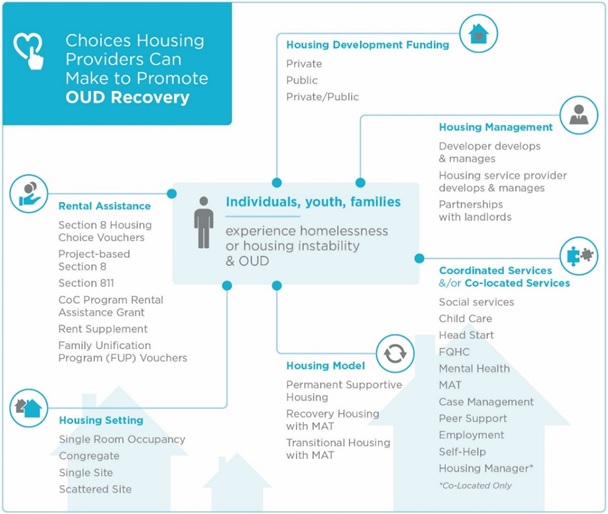Susan G. Pfefferle, Samantha S. Karon and Brandy Wyant
Abt Associates
Printer Friendly Version in PDF Format (4 PDF pages)
ABSTRACT
ASPE recently completed a research project, conducted by Abt Associates, that explored homelessness and opioid use disorder, along with the evidence base for different models for care. This brief is highlights of findings from the project.
This Report Highlights was prepared under contract #HHSP233201600010I between HHS's ASPE/DALTCP and Abt Associates. For additional information about this subject, you can visit the DALTCP home page at https://aspe.hhs.gov/office-disability-aging-and-long-term-care-policy-daltcp or contact the ASPE Project Officer, Emily Rosenoff, at HHS/ASPE/DALTCP, Room 424E, H.H. Humphrey Building, 200 Independence Avenue, S.W., Washington, D.C. 20201; Emily.Rosenoff@hhs.gov.
DISCLAIMER: The opinions and views expressed in this report are those of the authors. They do not reflect the views of the Department of Health and Human Services, the contractor or any other funding organization. This report was completed and submitted on February 11, 2019.
The Office of the Assistant Secretary for Planning and Evaluation recently completed a research project, conducted by Abt Associates, that explored homelessness and opioid use disorder (OUD), along with the evidence base for different models for care. Below are highlights of findings from the project. For the full report see: https://aspe.hhs.gov/basic-report/choice-matters-housing-models-may-promote-recovery-individuals-and-families-facing-opioid-use-disorder.
Evidence from the literature on the risk related to OUD and housing instability: Substance use disorder (SUD) increases a person's risk of homelessness, and research shows SUD to be a leading cause of homelessness in the United States. Individuals with SUD are more likely to experience chronic homelessness and to have become homeless at an earlier age compared to individuals without an SUD. Adults who experience homelessness are nine times more likely to die from an opioid overdose than adults with stable housing. Veterans are more likely than civilians to experience homelessness, and veterans seeking treatment for OUD are ten times more likely to experience homelessness than veterans without OUD who seek services through the U.S. Department of Veterans Affairs.
Medication-assisted treatment (MAT) models for individuals still experiencing homelessness: For individuals still experiencing homelessness, a number of innovative delivery approaches of MAT have shown positive outcomes for those less likely to participate in MAT because they are unstably housed. The report examines a number of models that administer MAT to individuals who are still experiencing homelessness, including: Shelter-Based Opioid Treatment, Office-Based Opioid Treatment (OBOT), Stepped Treatment Engagement Program (STEP), and the Downtown Emergency Shelter Center (DESC) program in Seattle, which brings MAT services to clients in a range of settings.
Housing models that promote recovery: The models identified generally fell into two broad categories: Housing First (an evidence-based model with no preconditions for accessing housing) and Recovery Housing (a home environment of peer support that emphasizes abstinence with or without MAT). The report also identified the "Housing Choice" model at Central City Concern in Portland Oregon which is a blend of both options.
Gaps in the research literature: Additional research on the intersection of homelessness, intervention models, and OUD treatment outcomes is needed. This project did not identify any rigorous evaluations of recovery housing programs related to OUD. Additionally, the report did not identify any models or research specifically around youth homelessness and OUD. The project did not identify any comparative effectiveness research of the Housing First Evidence-Based Practice and other housing models for people with OUD.
The report identified a number of strategies that were important to building successful housing models to support clients in their path to recovery. The researchers heard repeatedly that client choice was critical for determining the right program "fit". Successful housing providers build trust with individuals served, provide peer support services, engage the community, collaborate closely with health and behavioral health providers, and use funds braided from multiple sources to pay for housing, treatment, and supportive services. One innovative model coordinated closely with a local independent pharmacy. This research also suggests it is key to have partnerships between housing providers, service providers, local pharmacies, and peer supports. It was further observed that experts agreed MAT alone is insufficient, and MAT should be combined with a range of supportive services such as employment services that can assist people to be self-sufficient and provide hope for recovery.
Case studies: The report includes four case studies of housing models: Avalon Housing (Michigan), HousingNow (Pennsylvania), HomeSafe (New Jersey), Pearl House (Ohio). Two of these programs serve individuals and two serve families.
 |
OPIOID USE DISORDER, HOUSING INSTABILITY AND HOUSING OPTIONS FOR RECOVERY
This report was prepared under contract #HHSP233201600010I between HHS's ASPE/DALTCP and Abt Associates. For additional information about this subject, you can visit the DALTCP home page at https://aspe.hhs.gov/office-disability-aging-and-long-term-care-policy-daltcp or contact the ASPE Project Officer, Emily Rosenoff, at HHS/ASPE/DALTCP, Room 424E, H.H. Humphrey Building, 200 Independence Avenue, S.W., Washington, D.C. 20201; Emily.Rosenoff@hhs.gov.
Reports Available
Choice Matters: Housing Models that Promote Recovery for Individuals and Families Facing Opioid Use Disorder
- HTML https://aspe.hhs.gov/basic-report/choice-matters-housing-models-may-promote-recovery-individuals-and-families-facing-opioid-use-disorder
- PDF https://aspe.hhs.gov/pdf-report/choice-matters-housing-models-may-promote-recovery-individuals-and-families-facing-opioid-use-disorder
Choices Matter: Housing Models that May Promote Recovery for Individuals and Families Facing Opioid Use Disorder Report Highlights
- HTML https://aspe.hhs.gov/basic-report/choices-matter-housing-models-may-promote-recovery-individuals-and-families-facing-opioid-use-disorder
- PDF https://aspe.hhs.gov/pdf-report/choices-matter-housing-models-may-promote-recovery-individuals-and-families-facing-opioid-use-disorder
Housing Options for Recovery for Individuals with Opioid Use Disorder: An Environmental Scan
